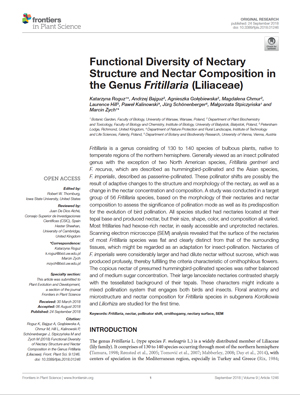NEWS 2018
Functional Diversity of Nectary Structure and Nectar Composition in the Genus Fritillaria (Liliaceae)
Katarzyna ROGUZ1, Andrzej BAJGUZ2, Agnieszka GOŁEBIEWSKA2, Magdalena CHMUR2, Laurence HILL3, Paweł KALINOWSKI4, Jürg SCHÖNENBERGER5, Małgorzata STPICZYŃSKA1, Marcin ZYCH1
Frontiers Plant in Science 9:1246 (2018)
https://doi.org/10.3389/fpls.2018.01246
1Botanic Garden, Faculty of Biology, University of Warsaw, Warsaw, Poland
2Department of Plant Biochemistry and Toxicology, Faculty of Biology and Chemistry, Institute of Biology, University of Bialystok, Bialystok, Poland
3Petersham, Lodge, Richmond, United Kingdom
4Department of Nature Protection and Rural Landscape, Institute of Technolog and Life Sciences, Falenty, Poland
5Department of Botany and Biodiversity Research, University of Vienna, Vienna, Austria
Abstract
Fritillaria is a genus consisting of 130 to 140 species of bulbous plants, native to temperate regions of the northern hemisphere. Generally viewed as an insect pollinated genus with the exception of two North American species, Fritillaria gentneri and F. recurva, which are described as hummingbird-pollinated and the Asian species, F. imperialis, described as passerine-pollinated. These pollinator shifts are possibly the result of adaptive changes to the structure and morphology of the nectary, as well as a change in the nectar concentration and composition. A study was conducted in a target group of 56 Fritillaria species, based on the morphology of their nectaries and nectar composition to assess the significance of pollination mode as well as its predisposition for the evolution of bird pollination. All species studied had nectaries located at their tepal base and produced nectar, but their size, shape, color, and composition all varied. Most fritillaries had hexose-rich nectar, in easily accessible and unprotected nectaries. Scanning electron microscope (SEM) analysis revealed that the surface of the nectaries of most Fritillaria species was flat and clearly distinct from that of the surrounding tissues, which might be regarded as an adaptation for insect-pollination. Nectaries of F. imperialis were considerably larger and had dilute nectar without sucrose, which was produced profusely, thereby fulfilling the criteria characteristic of ornithophilous flowers. The copious nectar of presumed hummingbird-pollinated species was rather balanced and of medium sugar concentration. Their large lanceolate nectaries contrasted sharply with the tessellated background of their tepals. These characters might indicate a mixed pollination system that engages both birds and insects. Floral anatomy and microstructure and nectar composition for Fritillaria species in subgenera Korolkowia and Liliorhiza are studied for the first time.




